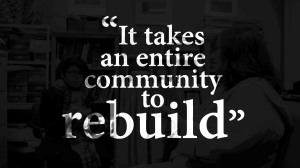Yes, high water indeed – 6 feet high , actually:
The CBS New York report above – published in late October of this year – shines light into what is arguably the smallest community along the south shore of Long Island-the town of Island Park. As you have already learned from said report, Island Park residents continue to partake in the process of rebuilding their once water-damaged homes.
Having partaken in said process for a little over two years now, residents have since found another way to define the term ‘rebuild’ .Allow me to explain:
The first meaning of ‘rebuild’ is entirely physical – It’s tangible, it’s labor-intensive, and it focuses on the actual reconstruction of thousands of homes damaged on the night of October 28, 2012.
Clearly, the amount of physical rebuilding for the town of Island Park has yet to die down. This is clearly a struggle that residents of the low-lying town continue to face.
Residents do not find themselves struggling while partaking in what would be the second definition of ‘rebuild’. But before I go into further detail, I believe it is necessary to have you learn more about the kind of impact Superstorm Sandy had left on Island Park and its larger, more populated neighbors. (More information on Sandy arriving on Long Island as a superstorm, and not a hurricane, can be found within this document by the National Hurricane Center.)
To do so, I have included in this post an interview with Professor JoAnn Thissen, a Geology professor at Nassau Community College. Though not a professor of meteorology, having an interview with her was beneficial when taking into account (1) her knowledge of coastal oceanography and (2) her previous experience as a resident of Island Park. The following recording contains snippets from our interview together :
Professor Thissen’s comments on community participation post-Sandy thus requires a new meaning to the term ‘rebuild’ , a meaning that residents such as myself learned of only after the superstorm’s emotional impact. This new meaning is strictly resident-oriented. It focuses not on the community of water-damaged, half-built houses, but of the people who used to reside within them. Indeed it was after Sandy when the community of Island Park residents inevitably rebuilt itself.
 It is here where the term takes on a more emotional meaning; Imaginary walls separating once-estranged neighbors were torn down overnight, and as a result, new relationships were based a singular experience and reinforced by the humanitarian acts of kindness occurring within the small town.
It is here where the term takes on a more emotional meaning; Imaginary walls separating once-estranged neighbors were torn down overnight, and as a result, new relationships were based a singular experience and reinforced by the humanitarian acts of kindness occurring within the small town.
Such was the case for Joanna Dickinson, currently a sophomore at the University of the Arts. Time not spent focusing on the art of photography within the Philadelphia campus is spent in Island Park, where her and her family have resided for decades.
Reuniting with her after several years, I had a chance to speak with Joanna about her experience when Sandy hit Island Park, as well as her thoughts on it having produced a more close-knit community.
A talented photographer, Joanna went on to discuss how an event as negative as Superstorm Sandy produced such positive results. This positivity not only includes closer bonds with fellow Island Park residents: According to Joanna, it has also brought about inspiration for her artwork.
As the art of photography is essentially a form of memory-keeping, photographs oftentimes carry heavy sentimental value with them. When Joanna and her family found the hundreds of photographs damaged by Sandy’s saltwater, therefore, she quickly turned her sorrow into inspiration for future projects. Such projects have actually included the re-using (and even re-creating) of these damaged mementos. These mementos, she says, “are too difficult to just throw away.”